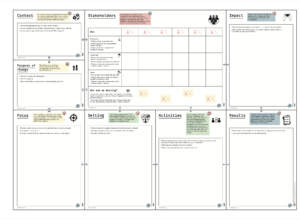Purpose: provide overview in collaborative processes on social issues
Who is it for: researchers, teachers, citizens, creative professionals
Technique: workshop (online and offline)
Type of tool: dialogue tool
Prior knowledge: low
Complexity: low
Time investment: 1 hour to a day
Downloads
Links
Related tools
What is the Co-Design Canvas?
The Co-Design Canvas is a qualitative and easy-to-use instrument to transparently start, flexibly plan, conduct, and evaluate a co-design process or initiative around societal challenges with various stakeholders.
Problems in collaborations often arise due to tensions between different stakeholders involved, for example due to unequal power relations, or because all kinds of things happen and arise that have not been anticipated, discussed and/or thought through in advance. The Canvas can provide insight into these matters and relationships and offer stakeholders a common language to reflect on the process. Co-design processes require dialogue, transparency, and empathy. The Co-Design Canvas can help facilitate this process and create insights into why processes succeed or fail.
The Canvas offers a tool for governments, citizens, companies, non-profit organizations, knowledge institutions and other stakeholders to communicate and collaborate clearly. From the start, the Canvas clarifies differences in interests, diversity in knowledge and experiences, and distribution of power. The Canvas focuses on the desired positive impact and concrete results and ensures that everyone’s voice is truly heard. In short, the Canvas is a tool that makes the variables of a co-design process clear and open to discussion, creating a common language, a clear starting point and an understanding of each other’s role and responsibility. The Canvas provides the flexibility to respond to unexpected events and the knowledge to better understand, conduct, plan and assess a co-design project.
In co-design and participation processes you want everyone to be able and allowed to make an equal contribution; that everyone’s voice is heard and included. But there are always differences in interests, experiences, knowledge level, role, social and organizational background, etc. The goal is to make these differences and similarities clear in an open, respectful, and transparent dialogue and to arrive at a common purpose and joint approach. How you facilitate this conversation is at least as important as who is at the table.
How to use the Co-Design Canvas?
When using the Co-Design Canvas as a facilitator or initiative taker, it is important to realise that the Canvas is primarily a means to determine the focus of the following co-design process (setting and activities) to achieve the desired concrete results and impact. Completing the Canvas is not a goal in itself.
The Co-Design Canvas specifically identifies eight variables that influence a co-design process: the co-design Context, Purpose, Stakeholders, Results, Impact, Focus, Setting, and Activities. These variables do not only affect the process as a whole but are also interrelated. The co-design stakeholders influence the co-design focus, which, in turn, determines who should participate in the process. The stakeholders then also determine which concrete results and impact are desired and feasible.
The top of the canvas is primarily about taking stock and exploring the problematic current context (why) and who should (ideally) be involved. The bottom side of the Canvas focuses on which co-design activities will be conducted with whom and where (how) to create opportunities for concrete results and positive impact (what). The left side of the Canvas represents the current problematic situation, the right side the desired situation. The method is especially relevant in situations where stakeholders tackle societal challenges.

Often, the problematic context and the initial purpose of change, which together comprise the current situation (why), form the starting point for collaboration. Throughout the process, you constantly move back and forth between the desired impact and concrete results (what), the stakeholders involved (who), the co-design focus, and its setting and activities (how). This results in a sharper co-design focus, while you may also discover that the actual problematic context is much broader or more complex, and that you need to adjust the common purpose accordingly. The Canvas is a dynamic tool whose content is constantly changing. Finally, a co-design project is an iterative and joint learning process.
What is the origin of the Co-Design Canvas?
The Co-Design Canvas unfolded in an EU H2020 co-design research project together with citizens of Ransdaal and municipality officials of Voerendaal led by the Cube design museum, Anja Köppchen and Gène Bertrand, together with Inholland Professor Wina Smeenk in 2020. Based on this practice and inspired by the ‘Design Choices Framework for Co-creation Projects’ and the Business Model Canvas of Osterwalder. Canvas’ the seeds for the Co-Design Canvas were sown. Based on experiences in research and practice the Canvas evolved further the last 3 years in a paper and book.


